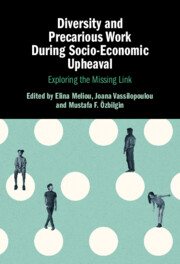Book contents
- Diversity and Precarious Work during Socio-economic Upheaval
- Diversity and Precarious Work during Socio-economic Upheaval
- Copyright page
- Contents
- Figures
- Contributors
- 1 Introduction
- 2 Pandemic Precarities and Gendered Biopolitics within the Neoliberal University
- 3 LGBTQ+ Individuals and Precarious Work
- 4 Age, Gender, and Precarity
- 5 How the (In)Ability of Using One’s Disability Strategically Reinforces Inequality and Precariousness amongst Disabled Workers
- 6 Classed and Gendered Experiences of Precarity in Dirty Work
- 7 Precarity and Diversity
- 8 Precarious Work in the Gig Economy
- 9 Refugees’ Vulnerability towards Precarious Work
- 10 Trapped in Precarious Work
- 11 How Precarity Is Threaded into Migration Rules
- 12 Culture, Precarity, and Dignity
- 13 Transforming Humanitarianism
- 14 Artificial Intelligence, the Gig Economy, and Precarity
- Index
- References
8 - Precarious Work in the Gig Economy
Diversity, Race and Indigeneity Lenses
Published online by Cambridge University Press: 01 February 2024
- Diversity and Precarious Work during Socio-economic Upheaval
- Diversity and Precarious Work during Socio-economic Upheaval
- Copyright page
- Contents
- Figures
- Contributors
- 1 Introduction
- 2 Pandemic Precarities and Gendered Biopolitics within the Neoliberal University
- 3 LGBTQ+ Individuals and Precarious Work
- 4 Age, Gender, and Precarity
- 5 How the (In)Ability of Using One’s Disability Strategically Reinforces Inequality and Precariousness amongst Disabled Workers
- 6 Classed and Gendered Experiences of Precarity in Dirty Work
- 7 Precarity and Diversity
- 8 Precarious Work in the Gig Economy
- 9 Refugees’ Vulnerability towards Precarious Work
- 10 Trapped in Precarious Work
- 11 How Precarity Is Threaded into Migration Rules
- 12 Culture, Precarity, and Dignity
- 13 Transforming Humanitarianism
- 14 Artificial Intelligence, the Gig Economy, and Precarity
- Index
- References
Summary
The meteoric growth of the platform economy, its economic underpinnings as well as the accompanying human practices, have provoked academic debates as well as shone a light on its praxis. In this gig economy, the conditions of work have significantly changed from what used to be relatively stable markets, moored self- and work identities, with predictable technological cycles, established jobs in which individuals were ‘tied’ into roles and their organisations-of-employ, sufficient income during work and non-work periods, and with substantive protections through employment rights and social protection – also known as the standard employment relationship (SER). The gig economy has introduced efficiencies in engaging customer segments and supply chains, however its non-standard forms of employment (NSFE) which includes part-time, temporary, and zero-hour contracts and dependent self-employment, has brought with it: low pay, insufficient and variable hours, short-term contracts, and limited social protection rights (Rubery, Grimshaw, Keizer & Johnson, ). The majority of employees, migrants and foreigners, remain dependent on in-country structures to grant them SER rights – in many countries, though, they do not have the power to engage with those structures and no way to build on and improve their rights. The emerging story of the gig economy divides scholars, particularly in relation to the distribution of the economic and social benefits of this ‘new economy’, as well as international relations (IR) scholars in that race and indigeneity, and its intersections, have been missing in many of the debates. The challenge remains to upend the coloniality and neoliberal nature of work, and create a more democratic and inclusive labour market, in which more of the economic benefits are fairly distributed among those who participate in the gig economy and not just for indigenous citizens exclusively.
Keywords
- Type
- Chapter
- Information
- Diversity and Precarious Work During Socio-Economic UpheavalExploring the Missing Link, pp. 137 - 162Publisher: Cambridge University PressPrint publication year: 2024



